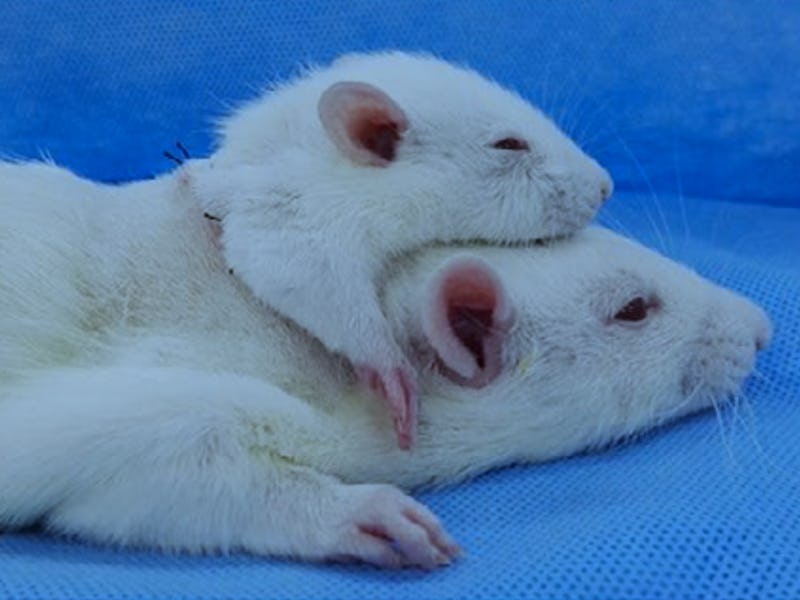This Double-Headed Rat Is the Future of Head Transplant Science
(Yes, both heads are alive.)

At first glance, the double-headed rat created by Chinese scientists doesn’t look like a double-headed rat. It looks more like a small rat, slumped on the back of its bigger friend as if it’s had a really tough day and just needed a pal.
But coarse black stitches at the smaller rat’s nape signal something far weirder: This is a double-headed rat.
The disturbing creature was very much alive when the scientists snapped its (their?) photo as proof that their new head transplantation technique is viable and effective. The photos accompany their new study in the journal CNS Neuroscience and Therapeutics, outlining what makes their technique a superlative one in the head transplant space.
Other techniques exist, of course. Scientists have been trying to perfect head transplantation for decades, but immune systems generally tend to reject foreign heads. In the 1950s, for example, when a Soviet researcher named Vladimir Demikhov made 19 attempts at making two-headed dogs, he found that those that managed to survive the transplantation phase ultimately died from overwhelming immune rejection. Likewise, the attempt to transplant one monkey’s head onto a beheaded peer by the Cleveland-based neurosurgeon Robert White, in 1970, resulted in brain death after nine days, also for immunological reasons.
In this photo of the rats taken from the study, it appears that they're just snuggling.
In the new paper, the scientists show how they managed to surmount this issue, along with the problem of weak blood supply to the donor brain. Their attempt to “improve on the bicephalic preparations employed by past pioneers” involved not two but three rats, a couple of silicon “vessels,” and an external pump to keep blood flowing.
The rat “triads,” as they refer to them in the paper, consist of a donor, a recipient, and a blood supply. The technique seems simple, in theory: The donor’s chest gets opened up, then its two major veins get hooked up to the recipient’s. Until the donor and recipient are fully hooked up to each other through their blood vessels, however, an external pump keeps blood supply to the donor brain — routed from the blood supply rat’s body — flowing freely.
This photo from the study shows the "triad" of rats necessary for the head transplant.
The researchers took additional steps to avoid other issues head transplanters normally encounter. To prevent brains from dying from hypothermia, for example, they kept donor blood warm using a “temperature change device.” They were careful, also, to choose recipient-donor pairs that weren’t too different in size, so that the big rat’s heart wouldn’t overwhelm blood flow to the smaller rat’s brain.
In the end, 14 of the rat triads survived for about 36 hours (it’s unclear how many there were to begin with, though) — and by survive, the researchers mean that all the rats involved stayed alive. They verified this by measuring the rats’ vital signs: Blood oxygen levels appeared normal, EKGs showed that blood was flowing normally, and there weren’t any signs of tissue necrosis. But perhaps most telling is the fact that rats showed signs of feeling pain, and their eyes moved in response to visual stimuli. In the paper, the researchers don’t mention running into any immune system problems, but that’s probably because the rats weren’t kept alive long enough to manifest them.
There are many questions to be asked about this work, the most obvious being, well, why? Head transplantation for humans is getting a lot of attention these days, especially since some researchers think it’s our best bet for transferring a person’s consciousness from one body to another. Figuring out whether that will actually work, however, requires attaching one head to another’s neck without causing instant brain death — which, as China’s two-headed rat illustrated, is possible, at least temporarily.